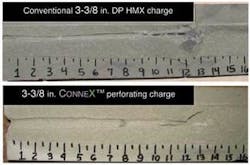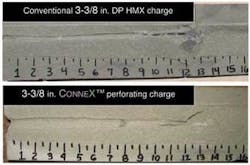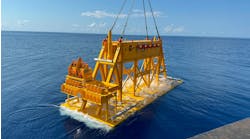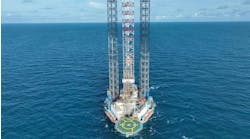Matt Bell, GEODynamics Inc.
Joe D. Woods, International Pinpoint Co.
A joint development effort by three companies has introduced a new perforating technology that has the potential to dramatically increase the production capability of oil and gas wells.
The main purpose of perforating a well is to establish good flow communication between the well bore and the reservoir. In addition to being conduits for the inflow of hydrocarbons, perforations provide points of injection for water, gas, acid, proppant-laden gels for hydraulic fracture stimulations, and fluids that carry gravel used to control sand flow in weak or unconsolidated formations.
Conventional jet perforating
Perforating involves positioning a “gun,” which contains shaped-charge explosives made specifically for oil field perforators, down the wellbore next to a productive zone. A detonator is fired and a primer cord is ignited, which in turn detonates the charges. The resulting event creates holes through the well’s casing and cement and into the target zone, thus allowing formation fluids to flow into the well bore and up to the surface.
Shaped-charge (or “jet”) perforating has been commonly employed since the early 1950s. Jet charges evolved from the WWII military bazooka and replaced less powerful bullet perforators and other technologies such as mechanical cutters and hydraulic jets. Upon detonation of the shaped charges, perforations are created in a fraction of a second.
The charges employ an explosive cavity effect coupled with a metal liner to maximize penetration. They consist of a primer, outer case, high explosive and conical liner connected to a detonating cord. Once the main explosive is detonated, the liner collapses to form a high-velocity jet of fluidized metal particles that are propelled outward.
The perforating event could be described as a “punching action” as opposed to blasting, burning, or drilling. This punching effect is achieved by extremely high pressures stemming from impact of the initial portion of the jet traveling at approximately 30,000 ft/sec (9,144 m/sec).
Perforating-induced damage
An undesirable side effect of perforating is damage to the formation caused by the enormous jet impact pressure, which propels steel, cement, rock, and wellbore fluids into the surrounding formation. The shock effect also damages the rock, pulverizing formation grains and leaving loose debris in the newly created tunnels. Perforating damage consists of a crushed zone around the tunnel and debris inside the tunnels, which individually and collectively can limit both well productivity and injectivity. The removal of debris and damage from perforations is essential to ensure well success in all but the most prolific reservoirs. This often requires additional and sometimes costly procedures such as pumped treatments (acid stimulation, brine wash, hydraulic fracturing, etc.); use of special downhole cleaning tools (hydro-jetting, etc.); propellants (Stimgun technology, StimTube tool, etc.); static and dynamic under-balanced drilling and completion procedures; and other post-perforation debris management tools and techniques (filters, magnets, etc.).
Perforation clean-up efforts add cost and operational complexity. The procedures are often ineffective (especially in heterogeneous intervals) and as a consequence can actually reduce asset value.
Mitigating perforating-induced damage has been an important aspect of well completion research for decades. The objective is 100% clean perforation tunnels, regardless of rock quality or wellbore conditions. The elusive perfect perforation would yield 100% flow efficiency, providing greater effective inflow area and reduced flux rate - an important factor in controlling sand production and avoiding well failure. It would deliver a step change in flow performance (both productivity and injectivity) and allow all zones to contribute to the well’s productive flow characteristics, enhancing the inflow or injectivity profile and increasing ultimate reserves recovery.
ConneX Perforating
ConneX Perforating is a new generation of shaped charge resulting from the combined intensive development effort of GEODynamics, Shell International, and QinetiQ. This ReActive perforating technology is based on a concept created and patented by QinetiQ that is licensed to GEODynamics.
Upon detonation, this perforation solution creates a secondary reaction within the perforation tunnel. The reaction is formed by use of new liner technology, incorporating a carefully controlled combination of bimetallic liner material that is pressed under very specific conditions. The reactive properties of the charge develop high lateral pressures within the perforation tunnels, creating a self-cleaning action that results in open, debris-free holes.
The technology has been developed over the last three years through the financial support of the Shell GameChanger program. This program provides a process for capturing, nurturing and maturing game-changing ideas, until they are ready to be picked up in the mainstream technology development activities.
Perforating charge
The ConneX perforating charge is compatible with existing gun technology and traditional perforating procedures. Companies will not have to change the way they handle, ship, or operate perforating equipment. Even the outer case of this perforating charge looks like a traditional shaped charge. With ConneX Perforating, the company has added new functionality to the conventional shaped charge by changing the way it is made and the way it reacts upon detonation.
As previously mentioned, the normal debris found in perforations made with traditional charges consists of pulverized formation material, explosion by-products, and remnants of liner material. Some debris can be flushed from the perforation if an effective rate of flow is established. However, in low-permeability formations, in zones that will immediately be fractured, in injection wells that will not be reverse-flushed, and whenever an effective underbalance cannot be established to induce flow, the debris remains trapped in the perforation tunnel. This seriously impairs the perforations’ flow characteristics.
The perforating charge is extremely advantageous in such cases. The event created by the perforating technology results in the expulsion of debris and crushed zone material that would normally remain trapped in the perforation tunnels.
Test results
In the case of the Berea sandstone tests, the results from using this perforating charge are:
- +44% clear tunnel depth
- +164% tunnel surface area
- +355% tunnel volume
- +35% improvement in flow performance.
Tests conducted during development positively indicate a strongly exothermic, Hume-Rothery intermetallic reaction between liner components, induced by the shock upon detonation. This secondary event occurs within the perforation tunnel in the microseconds after it is formed. The secondary event effectively “cleans” the perforation tunnel of debris and removes crushed material from the tunnel wall, leaving a near-ideal and optimized flow path.
Flow lab tests have demonstrated that this new class of perforator has the following characteristics:
- A secondary reaction is created upon detonation
- Perforating tunnels are effectively “clean-ed” and free of both debris and crushed zone
- The perforator does not require underbalanced conditions to clean the perf tunnel
- Positive cleaning effects generated by the perforating technology are relatively insensitive to rock type or quality
- Perforation tunnels created by the perforating charges exhibit superior flow characteristics that improve hydrocarbon recovery.
For further information, contactintlpinpoint@ sbcglobal.net




